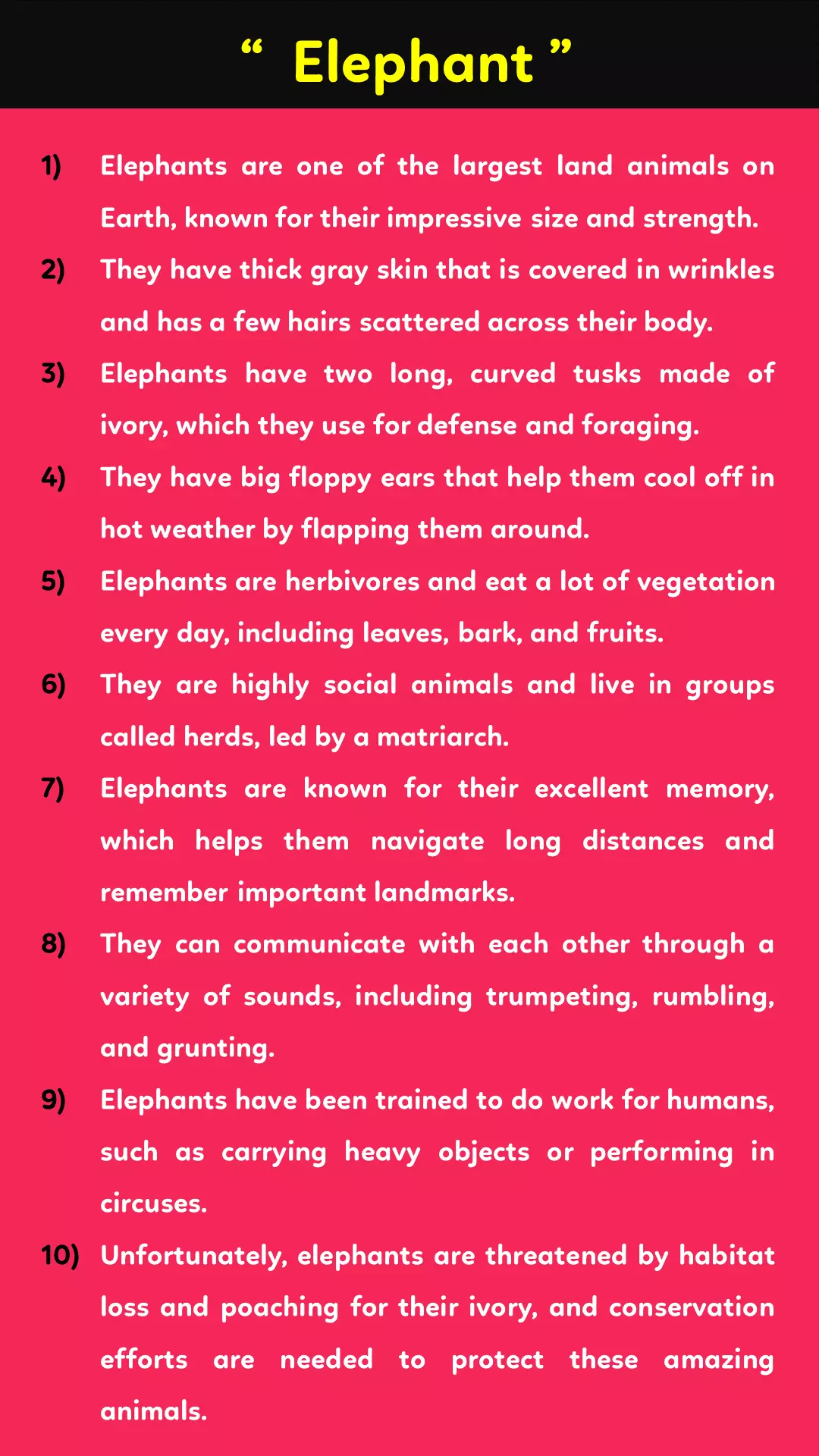Table of Content
Through this article, we are sharing 10 lines on Elephant in English. This post will help those students who are looking for information about Elephant in the English Language.
If any student wants to write a short essay on Elephant then, this post is very useful for them. Information about Elephant is very simple and easy for writing purposes.
These sentences on Elephant are very short and easy to understand, so any level of student can write on this topic.

Short essay on Elephant in English ( In 3 Formats )
Format-1
- Elephants are one of the largest land animals on Earth, known for their impressive size and strength.
- They have thick gray skin that is covered in wrinkles and has a few hairs scattered across their body.
- Elephants have two long, curved tusks made of ivory, which they use for defense and foraging.
- They have big floppy ears that help them cool off in hot weather by flapping them around.
- Elephants are herbivores and eat a lot of vegetation every day, including leaves, bark, and fruits.
- They are highly social animals and live in groups called herds, led by a matriarch.
- Elephants are known for their excellent memory, which helps them navigate long distances and remember important landmarks.
- They can communicate with each other through a variety of sounds, including trumpeting, rumbling, and grunting.
- Elephants have been trained to do work for humans, such as carrying heavy objects or performing in circuses.
- Unfortunately, elephants are threatened by habitat loss and poaching for their ivory, and conservation efforts are needed to protect these amazing animals.
You May Also Like
Format-2
- Elephants have a long, flexible trunk that they use for a variety of tasks, including drinking, eating, and breathing.
- They have four sturdy legs with thick, padded feet that help them walk quietly and efficiently.
- Elephants can weigh up to several tons and stand over 10 feet tall at the shoulder.
- They are native to Africa and Asia, and there are two different species: African elephants and Asian elephants.
- Female elephants are called cows, and male elephants are called bulls.
- Elephants are intelligent animals and have been known to use tools, solve problems, and show empathy for other elephants.
- They are also capable swimmers and can use their trunk as a snorkel to breathe underwater.
- Elephants have a unique social structure and form strong bonds with other members of their herd.
- They are a keystone species, meaning they play an important role in maintaining the ecosystem of their habitat.
- In many cultures, elephants are revered and considered symbols of wisdom, strength, and good luck.
Format-3
- Elephants have a gestation period of 22 months, which is the longest of any mammal on Earth.
- Baby elephants are called calves, and they can weigh up to 200 pounds at birth.
- Elephants are known for their incredible sense of hearing, which allows them to detect low-frequency sounds that humans cannot hear.
- They also have excellent eyesight and can see well in both bright daylight and dark conditions.
- Elephants use their tusks to dig for water, which they can detect using their sense of smell.
- They have a special digestive system that allows them to extract nutrients from tough plants and fibrous material.
- Elephants are highly emotional animals and have been observed mourning their dead and showing affection to their young.
- They have been the subject of many stories, myths, and legends throughout human history.
- In some cultures, elephants are trained for religious and ceremonial purposes, such as carrying royalty or participating in parades.
- There are many organizations working to protect elephants and their habitats, and you can help by learning more about these issues and supporting conservation efforts.

FAQ
- What is an elephant?
- What are the different species of elephants?
- What is the difference between African and Asian elephants?
- What do elephants eat?
- How long do elephants live?
- Are elephants endangered?
- How do elephants communicate?
- Are elephants social animals?
- How intelligent are elephants?
- Where can I see elephants in the wild?
An elephant is a large, herbivorous mammal with a long trunk, large ears, and thick gray skin. They are known for their intelligence, social behavior, and their importance in many cultures and religions.
There are three living species of elephants: the African bush elephant, the African forest elephant, and the Asian elephant.
African elephants are larger than Asian elephants, with longer tusks and larger ears. African elephants also have a more rounded back, while Asian elephants have a more level back. The trunks of African elephants have two “fingers,” while the trunks of Asian elephants have one.
Elephants are herbivores and eat a variety of plants, including grasses, leaves, bark, and fruits.
Elephants can live up to 70 years in the wild, although the average lifespan is usually around 50-60 years.
Yes, elephants are considered to be endangered due to habitat loss, poaching for their ivory tusks, and human-elephant conflict.
Elephants communicate using a variety of sounds, such as trumpets, rumbles, and grunts. They also communicate through body language, such as flapping their ears, waving their trunks, and making certain facial expressions.
Yes, elephants are highly social animals and live in family groups led by a matriarch.
Elephants are considered to be highly intelligent animals, with advanced cognitive abilities such as problem-solving, tool use, and empathy. They also have a strong memory and can recognize individual humans and other elephants they have met before.
Elephants can be found in a number of countries in Africa and Asia, such as Kenya, Tanzania, South Africa, Thailand, and India. It is important to choose responsible, ethical wildlife tourism options that prioritize the well-being of the animals and their natural habitats.
We hope! You will get some learning through this article. If you really like this article about Elephant in English, then please share it with your friends.
We working on helping the students to do their homework in a simple and easy way. Essay writing on Elephant is generally asked the students in Schools.